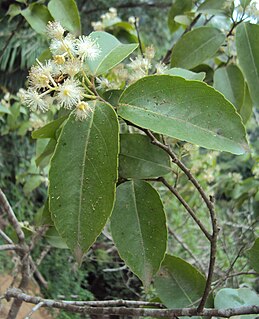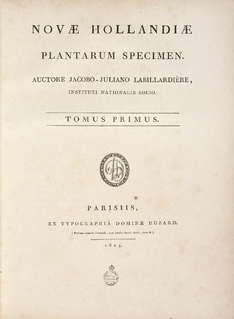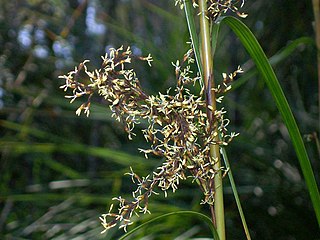
Lomatia tasmanica, commonly known as King's lomatia, is a shrub of the family Proteaceae native to Tasmania. Growing up to 8 metres (26 ft) tall, the plant has shiny green pinnate (lobed) leaves and bears red flowers in the summer, but yields neither fruit nor seeds. King's lomatia is unusual because all of the remaining plants are genetically identical clones. Because it has three sets of chromosomes and is therefore sterile, reproduction occurs only vegetatively: when a branch falls, that branch grows new roots, establishing a new plant that is genetically identical to its parent.
Triunia is a genus of medium to tall shrubs or small trees found as understorey plants in rainforests of eastern Australia. Members of the plant family Proteaceae, they are notable for their poisonous fleshy fruits or drupes. Only one species, T. youngiana, is commonly seen in cultivation.

Scolopia is an Old World genus of plants in the family Salicaceae.

Gahnia is a genus of sedges native to China, Southeast Asia, New Guinea, Australia, New Zealand and a number of Pacific Islands. The common name is due to the toothed margins. It often forms tussocks.

Gahnia filum, the chaffy saw-sedge, is a tussock-forming perennial in the family Cyperaceae, endemic to Australia. It grows to between 60 and 110 cm in height.
Gahnia trifida, the coastal saw-sedge, is a tussock-forming perennial in the family Cyperaceae, endemic to southern Australia.

Novae Hollandiae Plantarum Specimen is a two-volume work describing the flora of Australia. Facsimiles of the originals can be found in the online Biodiversity Heritage Library (Vol.1) and Vol 2).

Hesperilla chrysotricha, the chrysotricha skipper or goldenhaired sedge-skipper, is a butterfly of the family Hesperiidae. It is found in the Australian states of Victoria, Tasmania, South Australia and Western Australia.

Hesperilla donnysa, the donnysa skipper or varied sedge skipper, is a butterfly of the family Hesperiidae. It is found in the Australian Capital Territory, New South Wales, Queensland, South Australia, Tasmania, Victoria and Western Australia.

Hesperilla idothea, the flame sedge-skipper, is a butterfly of the family Hesperiidae. It is found in the Australian states of New South Wales, Queensland, South Australia and Victoria.

Hesperilla ornata, the spotted skipper or spotted sedge-skipper, is a butterfly of the family Hesperiidae. It is found along the non-tropical eastern seaboard of mainland Australia and in the adjacent mountain ranges.

Gahnia aspera known as the rough saw-sedge or round sawsedge is a tussock forming perennial plant, often seen in moist situations. The long strap like leaves grow to 80 cm long.

Gahnia grandis is a tussock-forming perennial plant found in southeastern mainland Australia and Tasmania.

Gahnia melanocarpa, known as the black fruit saw-sedge, is a tussock forming perennial plant in eastern Australia. Often found in the wetter forests or in rainforest margins, it is common on the coast but also seen in the tablelands.

Gahnia sieberiana, commonly known as the red-fruit saw-sedge, is a tussock-forming perennial plant in the family Cyperaceae, endemic to Australia. It is a widespread plant that favours damp sunny sites. Many insect larvae have been recorded feeding on the red-fruit saw-sedge. It may grow over 2 metres tall.
Gahnia radula, commonly known as the thatch saw-sedge is a tufted perennial sedge native to south-eastern Australia. The leaves are long, flat and rough, with sharp edges. It has a distinctive brown inflorescence, which darkens to black. It grows to 50–100 cm in height, spreads through its rhizomes and is found in eucalypt forest and grassy woodland.
Gahnia clarkei is a species of evergreen plant from a sedge family that can be found in Australia. The plant is 1.5–2 metres high, with the same width. They grow during summer and have large black to brownish flowers. The flowers contain seed heads that produce small red seeds.
Gahnia howeana is a flowering plant in the sedge family. The specific epithet refers to Lord Howe Island, where it is found. It was formerly lumped with Gahnia xanthocarpa, which is now considered to be endemic to New Zealand.
Triunia erythrocarpa, or spice bush, is a shrub of the family Proteaceae native to Queensland.

Lake Hawdon South Conservation Park is a protected area located in the Australian state of South Australia in the locality of Bray about 280 kilometres (170 mi) south-east of the state capital of Adelaide and about 18 kilometres (11 mi) east of the town of Robe.














